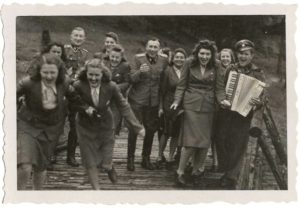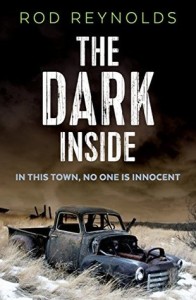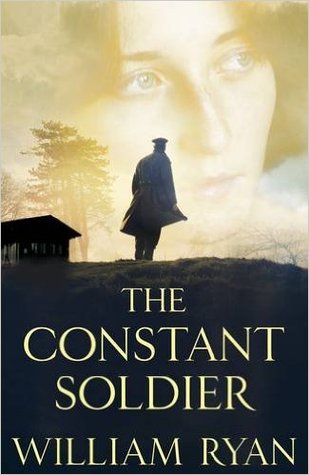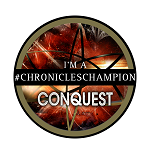
So today I’m handing the reigns to the brilliant Rod Reynolds who is having a chat with the equally brilliant William Ryan all about The Constant Soldier – out 25th August from Mantle it is one not to be missed. Genuinely. Details on the book after the interview and you know, handy links and stuff. But first here they are. And I loved this. Enjoy!

When Liz asked me if I’d like to talk to William Ryan about his new book, The Constant Soldier, I jumped at the chance. So it’s my pleasure today to pick his brains and get the lowdown on what is a stunning new novel – and one that will be a top contender for a whole slew of awards.
Thank you very much for taking the time to chat. Many congratulations on The Constant Soldier, a book that I found gripping, tense and immersive, and yet subtle and keenly observed. You mention in it how you were inspired by a series of photographs you found – can you elaborate on what they were, how you came across them, and what drew you to them?

The photographs come from an album put together by an SS officer called Karl Hoecker during the last few months of World War 2. You can see some of them here:www.ushmm.org/information/exhibitions/online-features/collections-highlights/auschwitz-ssalbum/album. Hoecker, at this time in his life, was adjutant to Richard Baer, the Commandant of Auschwitz and many of the photographs were taken at a rest hut for the officers and men at Auschwitz about 20 kilometres away from the camp. What I find strange about the photographs is that the people in them, despite including some of the worst of the Nazi war criminals, seem very ordinary. In one series we see SS female auxilliaries collecting blueberries in the nearby woods and lounging in deckchairs on the rest hut’s terrace. In others, SS officers gather for a dinner wearing civilian clothes before going on a hunting expedition. The most unnerving are at a party given for Rudolf Hoess, the first Commandant of Auschwitz on June 29th, 1944. In one, Hoess is telling a joke to Baer, Josef Mengele and Josef Kramer, the “Beast of Belsen”. If you didn’t know who these men were, and if you ignored the uniforms, you might think it was a corporate day out. And, of course, when these particular photographs were taken – in July 1944 – the war was effectively over. It made me wonder how these apparently ordinary people ended up as mass murderers – and what must they have been thinking at this stage of the war. And asking myself that sort of question is probably where the idea for The Constant Soldier came from.

Those are two fascinating lines of thought you raise. I want to come back to what they must have been thinking – which was one of the most gripping aspects of the novel – and start with the second point. One of the things that struck me about the book is how brave a choice it was to have a cast of characters who have been party to some of the greatest crimes against humanity, and to try to get under their skin. I wouldn’t go so far as to say I pitied them at any point, but you do an incredible job of examining the psychology of the situation, and the madness these men found themselves wrapped up. Were you nervous at all about tackling such a delicate subject, and what research (if any) led you to such a compelling portrait of these monsters?
The terrifying thing, for me at least, is it seems unlikely that these people set out to be mass murderers. Even Hitler, for example, wanted to be an artist and Himmler attempted, unsuccessfully, to run a chicken farm between 1925 and 1929. We can never know but, if they had been successful in their ambitions, perhaps we would never have heard of them. The same is true of most of the people in the photographs – they had other ambitions – but the circumstances and period of history they found themselves in provided them with a series of moral decisions and, in each case, they made the wrong decision. Those moral failures led them to where they were in 1944 when the photographs were taken. I worry that people label the Holocaust evil and think that explains it but I think you also have how that evil came about. And, most importantly, how individuals were carried away by a momentum which led to them completely losing any sense of right and wrong. It concerns me, when I hear some of the things that, for example, Donald Trump has said, that no society can ever feel complacent about its inherent goodness and that each of us, as individuals, need to be prepared in case we face a similar momentum – and be prepared to make the right moral choice. That sounds a bit dramatic – but the frightening thing is that almost nobody in 1923 Weimar Germany could have imagined a Nazi Germany in 1933 – and certainly not one in which the first concentration camp – Dachau – had already opened.
Was I nervous about the subject? Absolutely. This is sacred history for the many people who lost family members – not to mention, the still living survivors. It’s why everything in the novel is fictional – the “Camp” is based on Auschwitz but is never named. All of the characters in the novel are fictitious, as is the valley and the village where the novel takes place, although they have a basis in fact. It’s also the reason the novel never goes to the Camp – the Holocaust is there throughout the novel but it very seldom appears directly. That’s because I wanted to focus on this particular aspect – the small steps that lead an ordinary person, from an ordinary existence, to the point where they are committing incomprehensible evil. I’ve been concerned from the outset that some people might think I don’t confront the Holocaust in the way they might expect – and still am. But I think the book took me in a different direction and I don’t think, on reflection, I could have written it any other way.
I have to say, I never thought of how the book deals with the Holocaust in those terms – that you don’t confront it head on. It felt like it was always there, colouring everything and everyone, and I think that was part of the subtlety I mentioned at the start. But also, it fits the mood of the book, in that much of what I enjoyed on reading it was the sense of lingering evil and impending dread. In terms of the latter, I’ve said before that I think the book is a masterwork in suspense and delayed terror, with the Russian nightmare approaching from the east. Going back to what these men were thinking in the face of that coming reckoning, while I wouldn’t go so far as to say I felt sympathy for them, there were certainly times when I felt a sense of overwhelming regret on their part – for their predicament if not their actions. Did you find yourself pitying them at all?
I think as an author you have to empathise with your characters – as in understand their emotions and motivations to an extent – but that doesn’t mean I felt any sympathy for the SS men I portray in the novel. They made moral decisions which ended up with them being involved in the killing of other human beings – I don’t think they deserve sympathy. I think, also, that the regret some of them display in the novel is more self-pity then it is pity for their victims. They feel regret for their actions because they face the consequences. But if Nazi Germany had been winning the war at the same point, would they feel the same regret? I’m not sure.
I do feel sympathy for Brandt, the main character, because he was forced into the army and sent to the Eastern front against his wishes. He feels real guilt for his involvement in the merciless fighting and the evil he was a participant in and, crucially, he’s prepared to take positive action to atone for his guilt. I think we’re able to look on him in a kindlier light because of this determination to redeem himself and if the book is quite optimistic in the end, which I think it is, it’s because Brandt is prepared to risk his own life to undo his past – and the risk, to a certain extent, pays off.

Yes, that definitely comes through in the writing; Brandt’s bravery and willingness to do the right thing make him a very easy character to like, even though he has dark moments in his past. I was intrigued by your decision to make him an amputee – was that a way of giving the reader extra reason to sympathise with him? And did it make him harder to write in a practical sense (I’m thinking mostly of the action scenes here)?
To be honest, I’m not sure it was necessary in the end. I wanted him to be physically and mentally damaged – to the point where he almost has nowhere else to go, the worst has already happened to him. I also wanted him to be unrecognisable – to Agneta, at least. Now, however, I half wonder if it might not have been better if Agneta did recognise him. But, as you know yourself, it’s not a science this writing thing – and, given that version of his character gave the novel its shape and direction, it’s probably best to stick with it. Also, his vulnerability probably makes his bravery a bit more telling – I think anyway.
Funnily enough, a lot of the references to his disability slipped out in the rewriting – I only know this because he had a prosthetic in early drafts but we could find only one reference to it when we were checking a point. So that went as well, in the end.
Obviously the majority of the novel is told from the German perspective, but you introduce a Russian PoV character very effectively partway through. What made you decide to take that tack?
I’ve had a couple of Goodreads reviews wondering why Polya is in the story – but she and her tank represent the end of the war and, as long as they’re still coming, it’s a reminder that help is on the way – it may be too late for many but it is coming. That’s important for the novel, which would be much darker otherwise – and it also allows the novel to get away from the hut from time to time – which is also a good thing because Polya can be gentle and naïve in a way that no one around the hut can be, really. The novel needs her humanity and her optimism, I think.
Some quickfire questions before one more to wrap this up:
How long did the novel take you to write?
Write everyday or as and when?
What other novels of the period/genre would you direct readers who enjoyed The Constant Soldier to?
Who are your biggest writing influences?
What’s next for you?
It took three years – and at one stage I offered to give back the advance to the publisher because I just didn’t think it was going to work. And even when I thought it was finished it kept coming back from the dead, like a novel version of The Terminator. It’s not that I’m not proud of The Constant Soldier, I think it’s the best thing I’ve written by a distance, but I’m glad it’s being published on the 25th. There can’t be any more tweaking once it’s on the shelves.
I try and write everyday – I don’t always succeed. As you’ll know, there are lots of distractions in a writer’s life. I think you’re in the middle of blog tours at the moment, which can take up a lot of time. Speaking of which, I’m really looking forward to Black Night Falling (happy publication day!)
I don’t think I’d recommend them to read novels. Ordinary Men by Christopher Browning is the story of Reserve Police Battalion 101 and their involvement in the Holocaust. It’s been a book I’ve been thinking about for twenty years or so and a major influence on The Constant Soldier. I’d also recommend Gitta Sereny’s Into that Darkness and A Small Town near Auschwitz by Mary Fulbrook – not very cheery reading but, you know, if we don’t remember these things, we’ll end up repeating them.
As for influences – gosh – lots and lots of very different writers. Hilary Mantel, George MacDonald Fraser, James Ellroy, John Le Carre, Jane Austen, Walker Percy, Robert Graves, Georges Simenon, Dashell Hammett, Eudora Welty, Flannery O’Connor – and I’d probably give you a different list if you asked me tomorrow.
As for what’s next? I’m back to writing historical crime. I’m currently half way through the fourth in the Captain Korolev series. It’s set on an ice-bound icebreaker with ghosts, shamen and a little bit of cannibalism.
That last answer – completely as expected. Er, not.
Thank you again for your time and for offering such insight into your work. I’d end by asking about genre: as you mention, your previous books have been historical crime, but The Constant Soldier transcends genre for me, straddling historical, crime, war, literary and more. Did you think about how it would be classified when you were writing it, or were you just interested in telling the story you wanted to write, wherever that led you?
I think my publishers were expecting a locked room mystery, which they didn’t quite get – although it certainly feels like a thriller a lot of the time, to me anyway. When my publishers saw the early drafts, they considered selling it as a romance novel which led to a slightly weird Mills and Boon cover that we almost fell out over. At the end of the day, I hope it’s a good book, with good characters and a good plot. I think it really moves forward, which is what you learn from good crime fiction and I hope it takes the reader with it. I’ve been delighted with all the early feedback but the one description which really makes me happy and a lot of people have used – is “gripping”. That’s what I want form a book – the kind of story that keeps you up to the small hours and beyond and, after that, I don’t really worry too much about genre.
And, if it’s any good, a lot of that is down to my publishers believing in the book, I think, and pushing me to make it a much better book than it might have been if I’d been allowed to be lazy about it – which I really was tempted to be, if I’m honest.
Many thanks to William, and of course to Liz for having us on the site!
Thanks so much you two!
About the book:

1944. Paul Brandt, a soldier in the German army, returns wounded and ashamed from the bloody chaos of the Eastern front to find his village home much changed and existing in the dark shadow of an SS rest hut – a luxurious retreat for those who manage the concentration camps, run with the help of a small group of female prisoners who – against all odds – have so far survived the war.
When, by chance, Brandt glimpses one of these prisoners, he realizes that he must find a way to access the hut. For inside is the woman to whom his fate has been tied since their arrest five years before, and now he must do all he can to protect her.
But as the Russian offensive moves ever closer, the days of this rest hut and its SS inhabitants are numbered. And while hope – for Brandt and the female prisoners – grows tantalizingly close, the danger too is now greater than ever.
And, in a forest to the east, a young female Soviet tank driver awaits her orders to advance . . .
Read my review of The Constant Soldier HERE
Find out more here
Follow on Twitter here
To Order “The Constant Soldier” clickety click right HERE
Rod Reynolds is the author of The Dark Inside and Black Night Falling – both available now from Faber and both coming HIGHLY recommended from me. Read my review of The Dark Inside HERE and Black Night Falling HERE.
Follow Rod on Twitter here:


Happy Reading!






